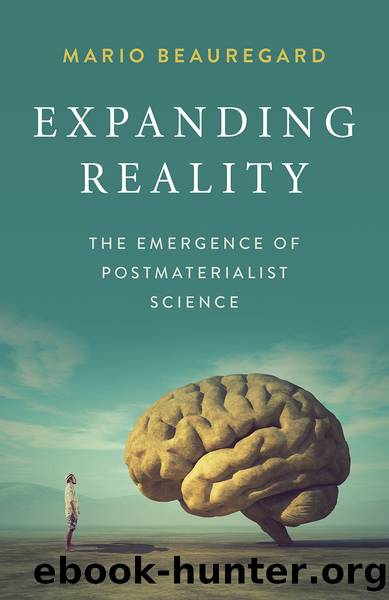Expanding Reality by Mario Beauregard

Author:Mario Beauregard
Language: eng
Format: epub
Publisher: John Hunt Publishing
Published: 2021-10-03T00:00:00+00:00
Biological Explanation Attempts That Fail
Materialist scientists have proposed biological explanations to explain the different aspects of NDEs. In my view, these attempts at explanation all fail to account for the richness and multidimensionality of these experiences, as well as their implications.
One of these hypotheses proposed by psychologist Susan Blackmore is that of the âdying brainâ141: A lack of oxygen (or anoxia) during the death process could produce abnormal excitement of neurons in the brain areas associated with vision, and such abnormal excitement would result in the illusion of seeing a bright light at the end of a dark tunnel. However, this hypothesis contains several flaws. First, tunnel observations are absent from several stories of experiencers. Secondly, if anoxia played an important role in the production of NDE, most individuals experiencing cardiac arrest should report an NDE, but this is not at all the case.142 On the other hand, when their oxygen levels drop significantly, people with poorly functioning hearts or lungs experience an âacutely confusing state,â which they remember little or nothing of, and in which they are very agitated and confused. The contrast is striking with those NDEs experienced with lucid awareness, clear reasoning, and well-structured thought processes. Experiencers also remember the NDE precisely, completely, and permanently. Had Blackmoreâs hypothesis been correct, the illusion of seeing a tunnel and a light should be stronger as the level of oxygen in the blood drops. However, individuals with low oxygen levels do not witness a tunnel or light, or other typical aspects of NDEs, and in some cases, some people experience NDEs even though they are not on their deathbed and oxygen levels in their brain are normal.143
Another research field indicates that the anoxia hypothesis is not valid. It has to do with the work done during the 1990s by Dr. James Whinnery of West Texas A&M. He conducted studies simulating the extreme conditions that occur during air combat maneuvers. During these studies, Whinnery subjected fighter pilots to significant gravitational forces in a giant centrifuge. Rapid acceleration significantly reduced blood flow and the delivery of oxygen to the brain. This caused the pilots to have short periods of unconsciousness, which Whinnery called âdreamlets.â The main characteristics of these dreamlets were confusion, impaired memory for events just before the loss of consciousness, and disorientation upon waking. These symptoms do not typically accompany NDEs, and no psychospiritual transformation has been reported following dreamlets.144
It has also been suggested that NDEs do not occur during the time of brain damage but just before or after, while the brain is more or less functional.145 The weakness of this interpretation lies in the fact that the state of unconsciousness induced by the stopping of the heart leaves amnesic individuals confused as to the events that took place immediately before or after the cardiac arrest.146 In addition, the confusion accompanying the loss or regaining of consciousness does not transform life at all, unlike NDE. On the other hand, in some cases, these experiences contain time markers that take the form of truthful reports of events that occurred at the precise moment of brain damage.
Download
This site does not store any files on its server. We only index and link to content provided by other sites. Please contact the content providers to delete copyright contents if any and email us, we'll remove relevant links or contents immediately.
The remains of the day by Kazuo Ishiguro(8897)
Tools of Titans by Timothy Ferriss(8311)
Giovanni's Room by James Baldwin(7259)
The Black Swan by Nassim Nicholas Taleb(7064)
Inner Engineering: A Yogi's Guide to Joy by Sadhguru(6758)
The Way of Zen by Alan W. Watts(6558)
Asking the Right Questions: A Guide to Critical Thinking by M. Neil Browne & Stuart M. Keeley(5712)
The Power of Now: A Guide to Spiritual Enlightenment by Eckhart Tolle(5683)
The Six Wives Of Henry VIII (WOMEN IN HISTORY) by Fraser Antonia(5459)
Astrophysics for People in a Hurry by Neil DeGrasse Tyson(5153)
Housekeeping by Marilynne Robinson(4400)
12 Rules for Life by Jordan B. Peterson(4278)
Double Down (Diary of a Wimpy Kid Book 11) by Jeff Kinney(4245)
The Ethical Slut by Janet W. Hardy(4220)
Skin in the Game by Nassim Nicholas Taleb(4208)
Ikigai by Héctor García & Francesc Miralles(4177)
The Art of Happiness by The Dalai Lama(4099)
Skin in the Game: Hidden Asymmetries in Daily Life by Nassim Nicholas Taleb(3964)
Walking by Henry David Thoreau(3926)
